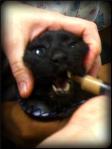10 Ways to Get Painkillers Into a Cat
Help! My Cat Refuses to Take Medicine!
VirtuaVet Offers 10 Quik Tricks to Give Cats Medicine
- Pill Pockets
- Piller
- Pencil With Eraser Tip, sticky butter, dexterous fingers
- Compounded Liquid Formulation with Eyedropper
- Compounded Flavor Chewies
- Crush medicine and mix with tuna juice, give via eyedropper (ask veterinarian or pharmacist if crushing is okay for that medication)
- Transmucosal
- Transdermal compounded
- Gelatin Capsules
- Melt-in-Your-Mouth Strips
How to Hold a Cat Still Enough to Give Liquid or Pill Medications
Ready, Aim, Blanket!
Gently burrito your kitty on the blanket. Start at the neck, just behind the ears and wrap the towel around kitty medium loosely. Include paws and claws under the blanket. Tuck kitty-in-blanket under your non-dominant arm (left if you are right-handed.)
Zygomatic Arches=Kitty “Handles”

Note the hand gently wrapped over the head, and note the syringe angled up and slightly back and midway along the jaw.
With kitty tucked under your left elbow and forearm on your lap or a sturdy tabletop, grasp your cat’s head by placing your left hand (your right hand if you are left-handed), up over the back of kitty’s head behind or just over the ears. Your thumb should be resting on your cat’s cheekbone (zygomatic arch) on the inside toward your body and your fingers should ne resting on the cat cheekbone facing away from your body. If you have cheekbone control, you have head control.
“If you have cheekbone control, you have head control,” says Doc Truli.
Approach from the Side
Lift preloaded syringe of medicine, dropper, piller, or pencil to kitty’s left side of the mouth. Approach from underneath and the side. Do not approach straight on from the front! The sight of your hand and the syringe coming straight in from the front frightens most cats and triggers them to bring a paw up to bat you away. Do this with your dominant hand, as the most dexterity is needed to guide the syringe and slowly push the plunger to feed your kitty without frightening him or her.
You can gently turn your cat’s head a little left, right, up, and down, to match the trajectory of your “loaded hand.”
Wiggle the Syringe Tip Against the Lips and Teeth 1/2-Way from Front to Back
Come from the side, and slightly underneath the side of the mouth. In between the sharp canine (eye) teeth and the back of the mouth, the premolars are small and short. Nudge the tip of the feeding syringe into the space between the front and back and between the jaws. Wiggle the syringe up and down and/or give a slight quarter turn at the midway place. This movement on the midway spot causes the jaw to open.
Slowly Inject Tiny Amounts of Medicine Upward to the Roof and Slightly to the Back of the Mouth
Slowly inject the medicine into the center of the mouth. Aiming at about a 15 degree angle for the roof of the mouth also promotes swallowing and helps prevent choking on the food. Aim behind the hump of the tongue, about 2/3 of the way back in the mouth. If you but liquid or a pill on the front of the tongue, your cat will spit that medication out before you have your hand down.
Gently Hold the Mouth Closed
Keep your cat’s head at a 20-30 degree upward angle to prevent spitting and hold the jaw gently closed. It must stay just loose enough for the cat to stick out his or her tongue upon swallowing. When you see that tongue, and if you also see the throat move like a swallow, you are safe to give the water chaser.
“A water chaser is just my way of saying, nobody wants to dry swallow anything, do they? So give your cat some water to wash the medicine down,” says Doc Truli.
Common Cat Painkillers and Best Ways to Give Them
Meloxicam
Meloxicam comes from the manufacturer (in the US) in a honey-flavored liquid. Cats cannot taste the flavor sweet. Cats do not have sweet taste buds. They still seem to like the meloxicam as it comes from the manufacturer. Just use the dropper and administer. Meloxicam can also be put in food.
The trick to putting meds in the cat’s food
You must give a hungry cat a spoonful of food with the meds hidden well. No sight, or smell of the food. The small amount of food is to confirm your cat eats the meds and to tap into the greed of a hungry cat.
“We put medication in a small amount of a hungry cat’s food, hoping the cat does not chew or taste. Some cats will snarf the glob of food and never notice the medication. You are lucky if your cat is this piggy!” says the Doc.
Buprenorphine
Buprenorphine tastes bitter. You can squirt it into the cheek pouch. Your cat will probably drool, squint, glare at you, shake his or her head, and run off to sulk. This medicine is such a powerful, awesome painkiller for cats, it is worth it!
Caution: Never Give Human Over-the-Counter (OTC) medicines to a cat. Most of them kill your cat; all of them make your cat sick. Tylenol, especially, will kill your cat. Never. Never. Never.
You probably already knew that, but just to make sure: do not do it! Only follow your veterinarian’s advice for cat painkillers!
See also: VirtuaVet’s Professional Tips to Give Painkillers to a Cat




Trackbacks and Pingbacks